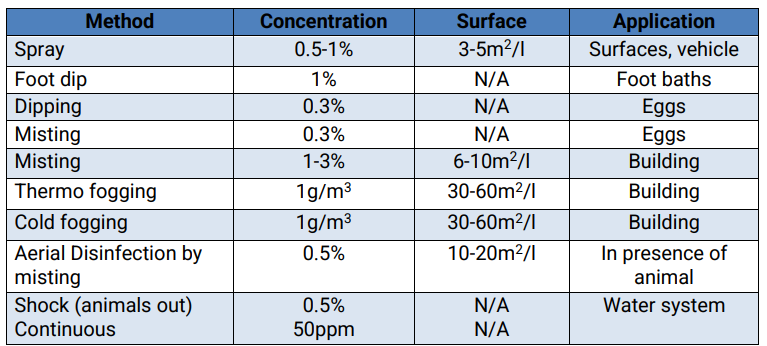



How to stop Avian Influenza viruses from further spreading?
Halamid® has been shown to be one of the most efficacious disinfectants against AI viruses.Highly pathogenic avian influenza (HPAI) has been keeping Europe in its grip for years. Vaccination shows promise, but not all countries are engaged to do so yet. In the meantime, monitoring and biosecurity are the most effective ways to keep control over this epidemic. Halamid® has been shown to be one of the most efficacious disinfectants against AI viruses.
Avian Influenza (AI) is a major viral disease and divided into two categories: low-pathogenicity and high-pathogenicity avian influenza (LPAI and HPAI, respectively). The AI virus is able to show rapid genetic change by recombining with other influenza viruses to form different viral subtypes. LPAI is found worldwide, predominantly in wild free-ranging waterfowl near wetlands and other aquatic environments. These birds are typically asymptomatic and carry the virus year-round.
Dealing with year-round reservoir
Because of wild bird migration, the poultry sector has always considered AI a ‘seasonal problem’ in Europe. But over the last few years, the disease turned into a true - year-round - problem, due to changes in wild bird distribution. The bird flu season seems to be getting longer and more intense. While it is unlikely for wild birds to develop HPAI from LPAI, transmission of an LPAI strain (particularly an H5 or H7 subtype) to poultry may incite evolution into HPAI. In addition, the virus (and associated mutations) can turn into new variations that pose risk to both livestock and humans.
Extra need for prevention and control
On European and member state level, all suspected cases of HPAI in poultry or captive birds must be investigated and reported. When a farm gets infected with HPAI, stamping-out measures and movement restrictions must be taken. At farm level, appropriate measures to prevent the direct or indirect contact of poultry with wild birds, together with preventive hygiene measures such as cleaning and disinfection are crucial. But are we doing enough? 2022-2023 is considered the most severe HPAI epidemic season ever in the EU, with the highest number of outbreaks in wild birds and poultry. This emerging threat calls for even better prevention, more intensive control, and novel measures such as vaccination.
Vaccination works, but has slow uptake
Vaccination may be used as an emergency or preventive measure, in addition to already implemented standard measures (e.g. surveillance programmes and biosecurity measures). Currently, there is one authorised vaccine against HPAI in chickens in the EU. France is the first EU country to vaccinate commercial birds and launched a nationwide bird flu vaccination campaign in October 2023. Since then, a couple of countries have slowly followed suit.
Veterinary authorities in Germany are planning to put vaccination into practice as well. In the Netherlands, authorities are still waiting for the results from a field trial in layers with two different HPAI vaccines (to be expected to hit the market in 2025). Italy and Hungary are active in field testing of vaccine candidates in turkeys and geese respectively. In 2021, the Czech Republic used an emergency vaccination plan in several flocks of their traditional ‘Czech geese’.

A disinfectant that is safe and powerful
Vaccination reduces circulation of the virus, and it is great to see that an increasing number of countries are introducing vaccination programmes. But it does not prevent new infections from occurring. This is why biosecurity measures remain critical at all times and are still the most effective way to prevent the introduction and spread of AI viruses within and between farms. Furthermore, if vaccination is implemented, it will require a reinforced surveillance protocol for vaccinated farms, so that those animals that are nevertheless infected may be identified and culled as quickly as possible. Poultry farmers have been using disinfectants, in all forms, for many years already. But not all products are equivalent in performance and safety.
Halamid® is a universal biocide, readily biodegradable, safe for humans, animals, and the environment. It is built on many years of expertise and works via an irreversible destruction of the envelope and cell material of microorganisms. The product is already widely used in the poultry sector.
Low concentration, high reduction of virus
Halamid® has been shown to be one of the most efficacious disinfectants against AI viruses, as it is powerful and with significantly higher endurance than other types of disinfectants such as peroxygens, phenols and QAC-aldehyde blends. This is proven by government laboratories. Independent testing by the respected Clinic for Birds, Reptiles, Amphibia & Fish at the University of Giessen, Germany, showed that even 0.1% concentration of Halamid® is able to reduce the AI virus (H7N1) load by more than 6 log10 (99.9999%). This was tested at low and high levels of organic soiling, and at lower temperatures (10°C) as well as standard (room) temperatures. Tests with the H1N5 variant showed similar results at a concentration of 0.2% of Halamid®.
Different application methods of Halamid®
Halamid® is effective against different types of AI viruses and can be applied to eggs, to any surface or object and can be used as water disinfectant (Table 1). Even the animal skin and feet can be treated without any adverse effects, while still offering superior elimination of the virus.
Table 1 - Different application methods of Halamid®.

If you like to know more about Halamid® and how it can help in your AI control programme, please get in touch with us.









